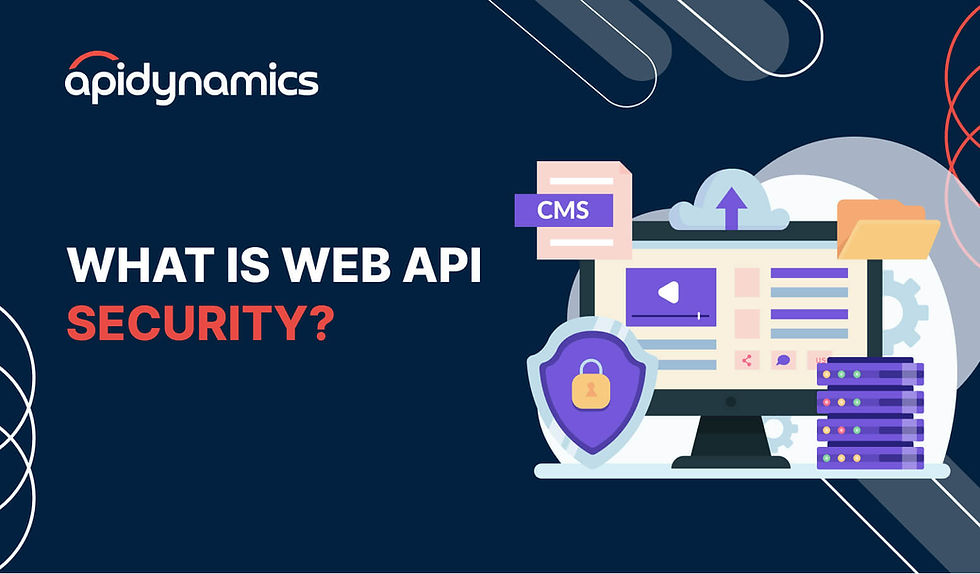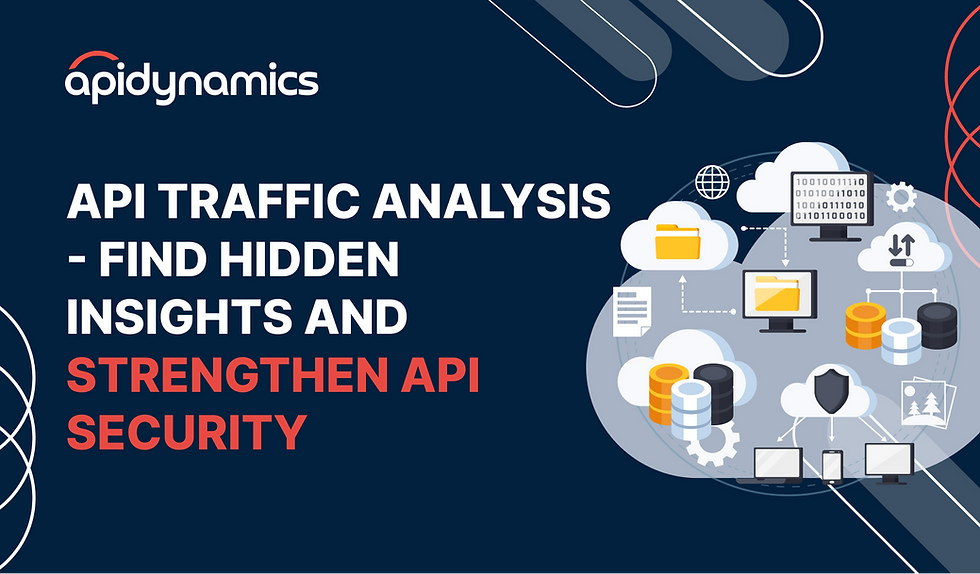What is Web API Security?
- Access Admin
- Aug 21
- 6 min read

Every time you order food online, book a taxi, or log in using your social media account, an API is working behind the scenes. Think of APIs as digital helpers that carry messages and share data between different apps and devices. Without them, most of the things we do online would not be possible.
But there is also a risk. Each API can become a doorway for hackers. If they find a weak spot, they can steal information, stop services from working, or even take control of systems. This is why keeping APIs secure is so important.
Web API security simply means protecting these APIs from anyone who should not be using them. It includes steps like checking who is allowed to enter (authentication), giving the right people the right level of access (authorization), keeping data safe (encryption), making sure inputs are clean (validation), and keeping an eye on everything (monitoring). All of this helps keep the data safe, correct, and always available.
In simple terms, it’s about making sure only the right people and systems can use an API, and that the information they exchange stays safe. Businesses today rely on techniques like OAuth/OpenID, API identity access management, and zero trust API access to protect their digital connections.
In this blog, we’ll explore why API security is critical, the risks that come with weak defenses, and best practices such as least privilege access management, adaptive MFA, and API security compliance.
Understanding Web API Security
Now that we know why APIs need protection, it’s easier to see what API security really means in practice. At its core, it focuses on three things: keeping data private, keeping it correct, and keeping it available when required.
To achieve this, APIs use different safety checks. Authentication proves the identity of the caller, and authorization decides what that caller can do. Encryption keeps information safe while it moves. Input validation blocks harmful requests before they reach the system. Monitoring ensures unusual activity does not go unnoticed.
As businesses depend on APIs in more ways, these checks need to be stronger. Smart devices rely on IoT authentication to stay secure. Companies working with vendors use partner API authentication. Automated systems often use machine to machine authentication to exchange data safely.
New models also change the way security works. With zero trust API access, no request is trusted by default. By adding continuous and adaptive trust, systems can adjust security in real time based on risk signals. This makes APIs much harder to exploit.
Core Components of Web API Security
APIs stay safe when a few core parts work together.
Authentication: Proves who is calling the API. Methods like API keys, tokens, or OAuth/OpenID are used.
Authorization: Decides what the caller can do. With least privilege access management, users only get the access they need.
Data protection: Keeps information safe. This means using encryption, tokenization, and following API security compliance rules.
Input validation: Checks requests before they enter. Blocks harmful or strange data.
Monitoring and logging: Watches activity in real time, raises alerts, and keeps records for audits.
These steps form the base of Web API security and help keep data and services safe.
Common API Security Vulnerabilities
APIs can have weak points. Hackers often use these to attack. Here are the most common ones:
Injection attacks: Attackers put harmful code into an API request. This can steal or change data.
Broken authentication: Weak login systems make it easy to steal accounts. Strong passwords and MFA help stop this.
Excessive data exposure: Sometimes an API shares more data than needed. This gives attackers extra information.
Insecure direct object references (IDOR): Attackers try to access files or data without permission. Proper checks block them.
Security misconfiguration: Leaving default settings or unused features open can create gaps for attackers.
Fixing these problems early keeps APIs safe and builds user trust.
Emerging Trends in Web API Security
API security is always changing. New tools and methods are being used to fight modern attacks.
AI and machine learning: These help spot unusual patterns in API use. They can also respond quickly to threats. This makes security smarter and faster.
API gateways: These act like a guard at the door. They control who can enter, manage traffic, and apply rules like rate limiting and caching.
Zero trust API access: In this model, no request is trusted by default. Every call must be checked and verified. It works well with continuous and adaptive trust, where security changes based on user behavior.
This is where companies like API Dynamics stand out. Their platform is built to handle modern threats through:
Protecting APIs from injection, token misuse, and protocol abuse.
Using runtime defense to block the OWASP Top 10 API threats.
Detecting bot activity with behavior-based anomaly detection.
Automatically enforcing rate limits, authentication, and access controls.
These trends, combined with solutions from providers like API Dynamics, show that API security is not just about blocking attacks. It is about building systems that can adapt, learn, and stay strong as threats keep growing.
Best Practices for Securing Web APIs
Keeping APIs safe needs regular care and the right methods. Here are some simple but powerful practices:
Use strong authentication and authorization: Methods like OAuth/OpenID, tokens, and role-based access help keep users safe.
Encrypt data: Always use TLS for data in transit and encrypt important data at rest.
Validate inputs: Check and clean all requests to block harmful data.
Implement rate limiting: Stop attackers from flooding the API with too many calls.
Run regular security audits: Testing and audits help find weak spots before hackers do.
Stay updated: Keep libraries, tools, and API software patched with the latest fixes.
Following these steps makes APIs stronger and reduces the risk of attacks.
Real-World Examples
Strong API security is not just theory. Many companies already use it every day to protect their systems and customers.
One example is a financial company that handles online payments. It uses OAuth/OpenID for login and API calls. This way, only verified apps and users can access account details. Even if someone steals a password, they still cannot break in without the right tokens. This protects sensitive financial data and keeps customer trust high.
Another example is an e-commerce platform that runs big sales during festivals. Millions of users visit the site at the same time. To handle this, the company uses an API gateway. The gateway checks every request, limits traffic if needed, and blocks suspicious activity. It also enforces rules like authentication and caching. This not only stops abuse but also ensures the site runs smoothly during heavy traffic.
These real stories show how API security practices, from authentication to API gateways, make a big difference. They protect data, prevent downtime, and allow businesses to serve customers without fear of attacks.
Conclusion
We’ve seen how APIs bring power and risk in equal measure. From authentication to monitoring, every layer matters. The threats are real, but the solutions are clear.
This is where API Dynamics gives businesses an edge. By blocking common attacks, detecting unusual behavior, and enforcing the right rules automatically, they help companies stay ahead of risks without slowing down innovation.
API security is an ongoing promise to protect users and data. With the right practices, and with partners like API Dynamics, that promise can be kept.
Ready to Strengthen Your API Security?
APIs are powerful, but they need protection to stay safe. With API Dynamics, you can secure every connection, stop common threats, and keep user trust intact.
FAQs
1. What is the difference between authentication and authorization in API security?
Authentication proves who the user or system is. Authorization decides what they can do after they are authenticated. Both must work together for safe APIs.
2. Why is input validation crucial for API security?
Because attackers often send harmful data through API calls. Input validation checks and blocks these bad requests before they reach the system.
3. How can I implement rate limiting in my API?
Rate limiting sets a maximum number of calls within a given time. It helps stop abuse and DoS attacks. Platforms like API Dynamics can enforce these limits automatically.
4. What are the best tools for monitoring API security?
Good monitoring tools track real-time activity, detect anomalies, and alert teams when something looks wrong. API Dynamics uses behavior-based detection to spot even unusual bot traffic.
5. How often should I conduct security audits for my APIs?
Regular audits are key. Most businesses do them quarterly or after any major update. The goal is to find and fix issues before attackers can.




Comments